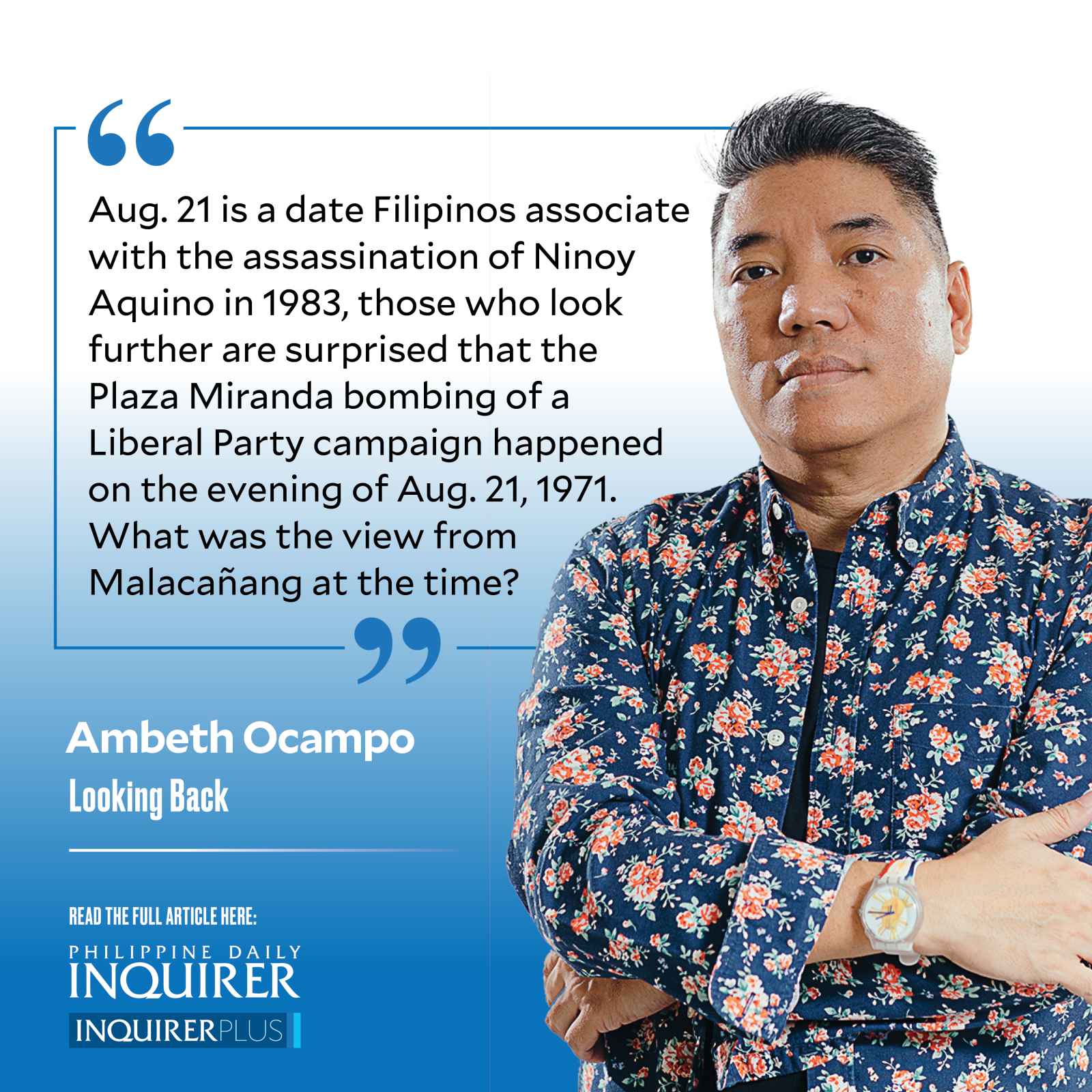Aug. 21 is a date Filipinos associate with the assassination of Ninoy Aquino in 1983, those who look further are surprised that the Plaza Miranda bombing of a Liberal Party campaign happened on the evening of Aug. 21, 1971. What was the view from Malacañang at the time?
Ferdinand Marcos Sr. monitored the situation, receiving reports from all over that kept him awake till 5 a.m. of Aug. 22. After a discussion with Generals Romeo Espino, Eduardo Garcia, Prospero Olivas, Mariano Ordoñez, Fidel Ramos, and Fabian Ver, the President signed Proclamation No. 889 (made public at 1 p.m. on Aug. 23, 1971), suspending the writ of habeas corpus. Marcos’ calibrated response flew in the face of Defense Secretary Juan Ponce Enrile, who strongly advised the declaration of martial law. One of the five articles Enrile published as a UP law student in the Philippine Law Journal was “The Effect of the Suspension of Habeas Corpus on the Right to Bail in Cases of Rebellion, Insurrection and Sedition” (1952).
In the Marcos diaries, there is a repeated reference to a “contingency plan” that had martial law as a last resort. It would be interesting to know when this plan was hatched, and what modifications were made to it, in the run up to September 1972. After Plaza Miranda, Marcos noted that “Gen. Ramos drew up the list of persons to be arrested drawn from the original contingency plan. The traditionalists among the communist leaders were expurgated leaving about 27 Maoists. Although later on five were added including Dante Simbulan, Sixto Carlos Jr….” Who were the listed targets in the “original” plan, and why were they targeted? For added measure, Marcos wrote:
“Just in case the arrests of the Maoists should invite violent action, I am preparing an order proclaiming martial law.
“For we cannot now compromise on this case. It must be solved. And neither should we temporize even with Ninoy Aquino. This man is most probably the mastermind of the whole dastardly plot. And in all probability his sidekick, a Commander Felman (true name—Bert Santos), executed the plan. They may not have planned to kill or injure so many people. But merely to cause a scare. Either Commander Felman decided to kill the rivals of Ninoy within the Liberal Party or he goofed. But the result was tragic.
“Ninoy Aquino is the most ruthless man in the Philippines today.”
On Aug. 23, 1971, Marcos called US ambassador Henry Byroade and asked:
“Whether it was true that Ninoy Aquino, as he has been busily spreading, was authorized by the US Embassy to buy the explosives and arms stolen from American bases, [Byroade] said that he lost respect for Ninoy Aquino when he first met the latter and Ninoy Aquino said that he was willing to kill to attain his purpose, and that he (Ninoy) has—kill that is.”
In an oral history interview, conducted in 1988, Henry Byroade recalled his first meeting with Ninoy as follows:
“In my first week in Manila, I met secretly once for about four hours with Aquino, who was the head of the opposition. We talked from about 10 o’clock until two o’clock in the morning. I was impressed with him in the beginning, but not later on. I don’t think Aquino would have been the answer for the Philippines … I’m talking about her husband, not Corazon … She was there for the whole discussion. She didn’t say anything.
“I was extremely impressed with Aquino for the first couple of hours, a very articulate man. He said a lot of nice things about what he wanted to do for the Philippine people and so forth. Towards the end he said things like, ‘Byroade, don’t make any mistake about me; I want power in the Philippines, and I’m willing to kill to get it, and I’ve done so a lot of times.’
“You know, it really turned me off on him. Now, the story is that Aquino, during his years in jail and his stay in the United States, turned religious, and became quite a different man. I never saw him after I left the Philippines [in May 1973]; I don’t know. People say he wouldn’t have made such a statement later on, but I don’t know.”
Working on the Marcos diaries off and on for some years is like completing a jigsaw puzzle with many missing pieces. I am far from forming a clear picture of the personalities and motives resulting in martial law in 1972 and onwards, but I can assure you that historical research will invalidate chismis and the storyline of that comedy called “Maid in Malacañang.”
—————–
Comments are welcome at aocampo@ateneo.edu


